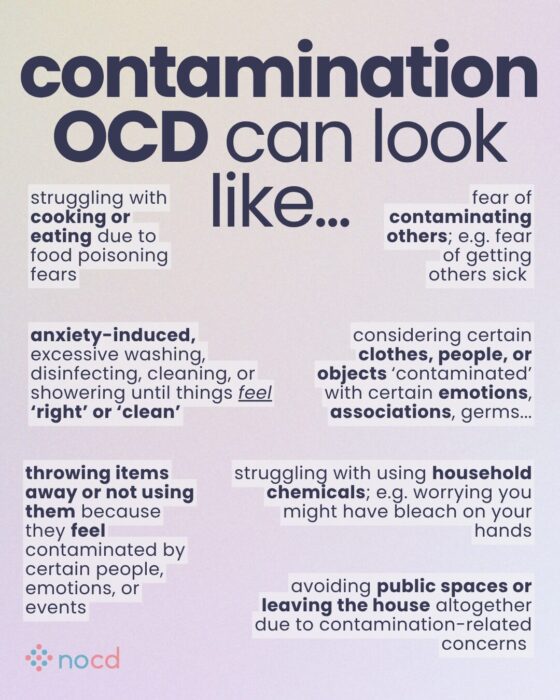Fear of harmful contamination OCD is a subtype of obsessive-compulsive disorder (OCD) where the primary fear isn’t just getting sick yourself, but spreading illness, toxins, or contamination to others and being responsible for their harm. According to research, 26.5% of people with OCD report having contamination-related obsessions.
In this article, we’ll explain what harmful contamination OCD is, how it’s different from typical contamination OCD, and how it’s treated.
Common obsessions in harmful contamination OCD
People with this subtype experience intrusive, distressing thoughts (known as obsessions) such as:
- What if I’m carrying a deadly virus and infect my family?
- What if I touched something toxic and passed it on?
- What if I accidentally poison someone by preparing food wrong?
These fears are unwanted, repetitive, and inconsistent with the person’s true values. They differ from general health anxiety, where the main concern is personal illness, because the focus is on harming others.
What triggers harmful contamination OCD?
People with harmful contamination OCD may be triggered by a wide variety of situations that might cause contamination or the transmission of a contaminant to others.
These might include:
- Bodily fluids
- Raw or spoiled foods
- Cleaning agents
- Schools
- Shopping carts
- Elevator buttons
Common compulsions in harmful contamination OCD
Compulsions are repetitive physical or mental acts done to relieve distress from obsessions or to prevent a feared outcome.
While not an exhaustive list, here are some examples of harmful contamination OCD compulsions:
- Excessive handwashing or showering to avoid spreading germs
- Disinfecting shared surfaces repeatedly
- Avoiding touching doorknobs, handles, or shared objects
- Throwing away items that “feel contaminated”
- Seeking reassurance from others about the activities that might result in others being contaminated
- Excessive online research about potential contaminants and modes of transmission
These compulsive behaviors may bring temporary relief, but ultimately reinforce the OCD cycle.
How is harmful contamination OCD different from typical contamination OCD?
In typical contamination OCD, the core fear is personal illness or dirtiness.
In harmful contamination OCD, the fear shifts to causing harm to others through contamination. For example:
- Standard contamination OCD → I’ll get sick if I touch this dirty surface.
- Harmful contamination OCD → If I touch this dirty surface, I might make someone else sick.
This distinction is important for accurate diagnosis and treatment planning.
How is harmful contamination OCD diagnosed?
There is no single test for harmful contamination OCD. Diagnosis is made through a clinical interview with a licensed mental health professional.
Clinicians may use tools such as the Yale-Brown Obsessive-Compulsive Scale (Y-BOCS), the Dimensional Obsessive-Compulsive Scale (DOCS), and the Structured Clinical Interview for DSM Disorders (SCID) to measure symptom severity. The key diagnostic feature is the presence of obsessions and compulsions that cause distress or interfere with daily life.
OCD can sometimes be confused with health anxiety, generalized anxiety, or phobias, but compulsive behaviors are the hallmark difference.
What is the best treatment for harmful contamination OCD?
The most effective treatment for harmful contamination OCD—and all subtypes—is exposure and response prevention (ERP) therapy. ERP is a specialized form of cognitive behavioral therapy (CBT) proven to be effective for OCD. General CBT, if not tailored for OCD, can sometimes be unhelpful or even worsen symptoms.
Studies show that ERP therapy is highly effective, with 80% of people with OCD experiencing a significant reduction in their symptoms.
Other approaches that may help include:
- Medication (typically SSRIs)
- Mindfulness-based strategies
- Acceptance and commitment therapy (ACT)
These are typically done in combination with ERP therapy, depending on the individual’s needs.
Severe or treatment-resistant harmful contamination OCD may benefit from the following therapies:
- Intensive outpatient programs (IOPs)
- Partial hospital programs (PHPs)
- Residential treatment centers (RTCs)
- Transcranial magnetic stimulation (TMS)
- Deep brain stimulation (DBS)
- Gamma knife radiosurgery (GKRS)
Find the right OCD therapist for you
All our therapists are licensed and trained in exposure and response prevention therapy (ERP), the gold standard treatment for OCD.
Bottom line
Fear of harmful contamination OCD is a challenging but highly treatable subtype of OCD. While it centers on fears of spreading germs or toxins and harming others, effective treatments like ERP therapy can help people break from compulsions and regain confidence in daily life.
Key takeaways
- Fear of harmful contamination OCD involves obsessions about spreading illness or toxins to others.
- The main difference from general contamination OCD is the focus on harming others, not oneself.
- Common compulsions include excessive cleaning, avoidance, and disinfecting.
- Diagnosis is based on obsessions and compulsions, often using tools like the Y-BOCS.
- The most effective treatment for harmful contamination OCD is exposure and response prevention (ERP) therapy, often combined with SSRIs and other adjunctive therapies.


